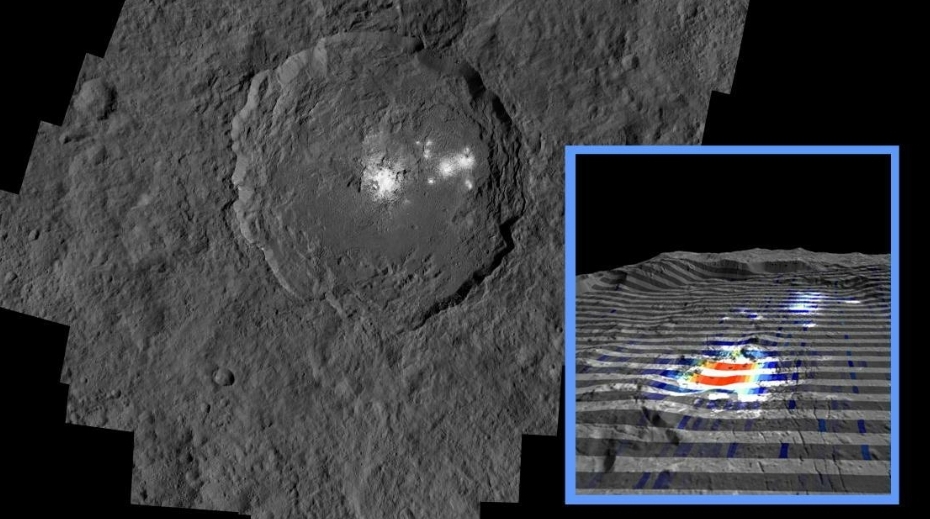Yeah you read it right, and it might be true as well. Ceres is the largest asteroid in the asteroid belt between Jupiter and Mars, also coming in Neptune’s Orbit. It was originally discovered back in 1801 as a planet and was later reclassified in 1850s. It is also the only body in the whole belt which has a round shape because of its own gravity and is 940kms wide. Nonetheless, these facts seem pretty normal for a celestial body then what’s with the aliens?
A space probe was launched by NASA, to study few protoplanets, bodies which are developing into a planet, of the belt, called Dawn in 2007. It majorly collected visuals and data on Vesta and Ceres. It discovered many bright spots on the surface of Ceres. These bright spots are also known as Faculae which also refers to a similar kind of surface phenomenon on Sun. These bright spots which are formed in between Solar Granules, are short-lived convection cells often produced by the concentration of Magnetic Field Lines. The brightest one of them being the Spot 5 which is located in an 80 km wide crater called Occator. While the crater has remains from an impact that happened 34 million years ago, the bright spot is just 4 million years old. Conspiracy theorists have been claiming it for a long time that they are greeting signals sent out from an Alien Base. The Satellite Dawn has been the closest to the asteroid as to 375km.
This Low-Altitude Mapping Orbit (LAMO) was designated to acquire data for at atleast three months with Dawn’s Gamma-Ray and Neutron Detector (GRaND) in order to investigate the gravity and to determine the chemical composition on and near the surface. The experiment of gravity will be monitored to see the pull of the planet, the same way as it is monitored in the high precision radio link to NASA’s Deep Space Network on Earth. The satellite used is a pointing control method which has been termed as a “hybrid” mode by the engineer, which will utilize a combination of reaction wheels and thrusters, fuelled by Hydrazine, to help the spacecraft navigate at the desired location. These thrusters would also ensure against any harm caused by the variations in the gravity field of Ceres. The Mission was monitored and handled by JPL for NASA’s Science Mission Directorate in Washington. It is a project of the discovery program, managed by NASA’s Marshall Space Flight Centre in Huntsville, Ala.
A fresh batch of images were released in Public Domain in 2015, when NASA asked the Public to guess what could possibly be causing this Bright spot to make its presence. The answers varied from Volcanic Activities taking place and assuming the presence of Ice to even Alien Activities taking place or Alien remains. The assumption of having Ice was backed by a factual observation of the rim. During the early morning period, Spot 5 would appear brighter and will fade as the dusk falls. This validated that sunlight was the primary source of this phenomenon, by heating up the ice just beneath the surface and causing it to blast off some kind of plume which appeared as haze around the spot. Moreover, Ceres is believed to be constituting atleast one quarter of ice.

But according to the mission’s principal investigator, this theory of having some kind of frozen liquid or ice was debunked. In 2015 itself, the scientists reportedly said that the bright spots may be related to some type of reflective mineral, possibly some salt. The speculation was made upon some form of brine which contained Hydrated Magnesium Sulphate (MgSO4·6H2O); the spots were also associated with ammonia-rich clays. The Arizona State University scientists have proposed that the bright spots can be best explained as results from Briny Water which has come there in the form of eruption from the Ceres’ core itself, and the salt minerals were sublimated.
Dawn also collected data that told due to the past geological processes, Ceres doesn’t have that many large craters as one would expect, even while having a heavily cratered surface. The Dawn team includes Arizona State University’s David Williams, who is the director of the Ronald Greeley Centre for Planetary Studies in ASU’s School of Earth and Space Exploration. “Ceres is revealing only slowly the answers to her many mysteries,” Williams says. “Completing the geological maps over the next year, and further analysis of the compositional and gravity data, will help us understand better Ceres’ geologic evolution.”
The body has also been featured in many science fiction stories across the 20th and 21st century. It is inhabited by humans in the TV series The Expanse, while one of the secret levels of the PC Game Descent takes place at Ceres.
To this time, there hasn’t been an exact and satisfactory observation as to what might be causing the bright spots to occur. Many people still think that it proclaims that some extra-terrestrial species did live on Ceres or still do.
Author – Devansh Dev
